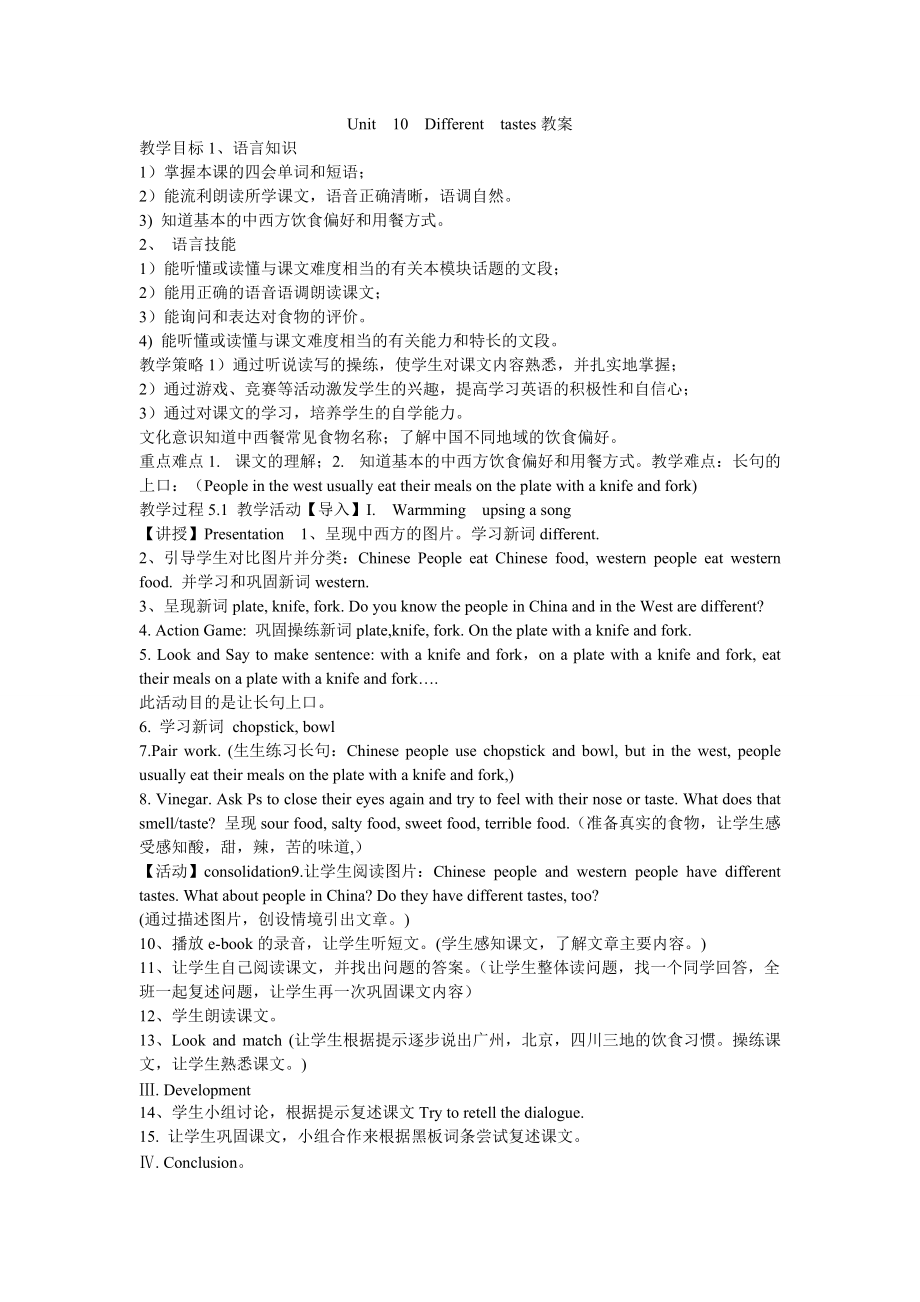《《Unit 10 Different tastes教案》小學(xué)英語教科課標版三年級起點五年級上冊教案5737.doc》由會員分享��,可在線閱讀�,更多相關(guān)《《Unit 10 Different tastes教案》小學(xué)英語教科課標版三年級起點五年級上冊教案5737.doc(2頁珍藏版)》請在裝配圖網(wǎng)上搜索。
1�、Unit 10 Different tastes教案
教學(xué)目標1、語言知識
1)掌握本課的四會單詞和短語���;
2)能流利朗讀所學(xué)課文�����,語音正確清晰����,語調(diào)自然���。
3) 知道基本的中西方飲食偏好和用餐方式����。
2、 語言技能
1)能聽懂或讀懂與課文難度相當(dāng)?shù)挠嘘P(guān)本模塊話題的文段�����;
2)能用正確的語音語調(diào)朗讀課文����;
3)能詢問和表達對食物的評價。
4) 能聽懂或讀懂與課文難度相當(dāng)?shù)挠嘘P(guān)能力和特長的文段�。
教學(xué)策略1)通過聽說讀寫的操練,使學(xué)生對課文內(nèi)容熟悉���,并扎實地掌握�����;
2)通過游戲��、競賽等活動激發(fā)學(xué)生的興趣�,提高學(xué)習(xí)英語的積極性和自信心���;
3)通過對課文的學(xué)習(xí)����,培養(yǎng)學(xué)生的自學(xué)
2�����、能力�����。
文化意識知道中西餐常見食物名稱����;了解中國不同地域的飲食偏好。
重點難點1. 課文的理解��;2. 知道基本的中西方飲食偏好和用餐方式�。教學(xué)難點:長句的上口:(People in the west usually eat their meals on the plate with a knife and fork)
教學(xué)過程5.1 教學(xué)活動【導(dǎo)入】I. Warmming upsing a song
【講授】Presentation 1、呈現(xiàn)中西方的圖片�。學(xué)習(xí)新詞different.
2、引導(dǎo)學(xué)生對比圖片并分類:Chinese People eat Chinese food, wes
3��、tern people eat western food. 并學(xué)習(xí)和鞏固新詞western.
3�����、呈現(xiàn)新詞plate, knife, fork. Do you know the people in China and in the West are different?
4. Action Game: 鞏固操練新詞plate,knife, fork. On the plate with a knife and fork.
5. Look and Say to make sentence: with a knife and fork,on a plate with a knife and
4�����、fork, eat their meals on a plate with a knife and fork….
此活動目的是讓長句上口����。
6. 學(xué)習(xí)新詞 chopstick, bowl
7.Pair work. (生生練習(xí)長句:Chinese people use chopstick and bowl, but in the west, people usually eat their meals on the plate with a knife and fork,)
8. Vinegar. Ask Ps to close their eyes again and try to f
5、eel with their nose or taste. What does that smell/taste? 呈現(xiàn)sour food, salty food, sweet food, terrible food.(準備真實的食物�����,讓學(xué)生感受感知酸���,甜��,辣��,苦的味道,)
【活動】consolidation9.讓學(xué)生閱讀圖片:Chinese people and western people have different tastes. What about people in China? Do they have different tastes, too?
(通過描述圖片�����,創(chuàng)設(shè)情境
6�、引出文章。)
10���、播放e-book的錄音����,讓學(xué)生聽短文��。(學(xué)生感知課文�,了解文章主要內(nèi)容�����。)
11����、讓學(xué)生自己閱讀課文,并找出問題的答案���。(讓學(xué)生整體讀問題�����,找一個同學(xué)回答���,全班一起復(fù)述問題���,讓學(xué)生再一次鞏固課文內(nèi)容)
12、學(xué)生朗讀課文���。
13���、Look and match (讓學(xué)生根據(jù)提示逐步說出廣州,北京�����,四川三地的飲食習(xí)慣�。操練課文,讓學(xué)生熟悉課文��。)
Ⅲ. Development
14���、學(xué)生小組討論�,根據(jù)提示復(fù)述課文Try to retell the dialogue.
15. 讓學(xué)生鞏固課文����,小組合作來根據(jù)黑板詞條嘗試復(fù)述課文���。
Ⅳ. Conclusion。
引
7��、導(dǎo)學(xué)生歸納本課的知識要點���。
重現(xiàn)本課的主要知識點�,使學(xué)生更好地掌握重點內(nèi)容���。
【練習(xí)】Writing根據(jù)學(xué)生的自己情況寫出家庭成員的飲食習(xí)慣。Writing about your family’s eating habit.
Unit 10 Different tastes
課時設(shè)計 課堂實錄Unit 10 Different tastes
第一學(xué)時教學(xué)活動【導(dǎo)入】I. Warmming upsing a song
【講授】Presentation 1�����、呈現(xiàn)中西方的圖片���。學(xué)習(xí)新詞different.
2�、引導(dǎo)學(xué)生對比圖片并分類:Chinese People
8���、 eat Chinese food, western people eat western food. 并學(xué)習(xí)和鞏固新詞western.
3�、呈現(xiàn)新詞plate, knife, fork. Do you know the people in China and in the West are different?
4. Action Game: 鞏固操練新詞plate,knife, fork. On the plate with a knife and fork.
5. Look and Say to make sentence: with a knife and fork,on a p
9��、late with a knife and fork, eat their meals on a plate with a knife and fork….
此活動目的是讓長句上口����。
6. 學(xué)習(xí)新詞 chopstick, bowl
7.Pair work. (生生練習(xí)長句:Chinese people use chopstick and bowl, but in the west, people usually eat their meals on the plate with a knife and fork,)
8. Vinegar. Ask Ps to close their e
10、yes again and try to feel with their nose or taste. What does that smell/taste? 呈現(xiàn)sour food, salty food, sweet food, terrible food.(準備真實的食物�,讓學(xué)生感受感知酸,甜�,辣,苦的味道,)
【活動】consolidation9.讓學(xué)生閱讀圖片:Chinese people and western people have different tastes. What about people in China? Do they have different tast
11����、es, too?
(通過描述圖片,創(chuàng)設(shè)情境引出文章��。)
10�、播放e-book的錄音,讓學(xué)生聽短文�����。(學(xué)生感知課文���,了解文章主要內(nèi)容����。)
11、讓學(xué)生自己閱讀課文�����,并找出問題的答案����。(讓學(xué)生整體讀問題,找一個同學(xué)回答��,全班一起復(fù)述問題�����,讓學(xué)生再一次鞏固課文內(nèi)容)
12�����、學(xué)生朗讀課文���。
13、Look and match (讓學(xué)生根據(jù)提示逐步說出廣州���,北京��,四川三地的飲食習(xí)慣�。操練課文,讓學(xué)生熟悉課文���。)
Ⅲ. Development
14�、學(xué)生小組討論����,根據(jù)提示復(fù)述課文Try to retell the dialogue.
15. 讓學(xué)生鞏固課文,小組合作來根據(jù)黑板詞條嘗試復(fù)述課文����。
Ⅳ. Conclusion。
引導(dǎo)學(xué)生歸納本課的知識要點����。
重現(xiàn)本課的主要知識點,使學(xué)生更好地掌握重點內(nèi)容���。
【練習(xí)】Writing根據(jù)學(xué)生的自己情況寫出家庭成員的飲食習(xí)慣����。Writing about your family’s eating habit.
 《Unit 10 Different tastes教案》小學(xué)英語教科課標版三年級起點五年級上冊教案5737.doc
《Unit 10 Different tastes教案》小學(xué)英語教科課標版三年級起點五年級上冊教案5737.doc

